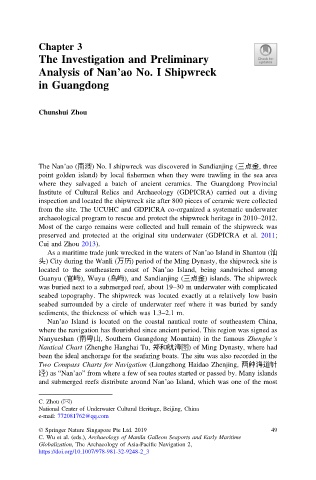Page 82 - Vol_2_Archaeology of Manila Galleon Seaport Trade
P. 82
Chapter 3
The Investigation and Preliminary
Analysis of Nan’ao No. I Shipwreck
in Guangdong
Chunshui Zhou
The Nan’ao (!!) No. I shipwreck was discovered in Sandianjing (!!!, three
point golden island) by local !shermen when they were trawling in the sea area
where they salvaged a batch of ancient ceramics. The Guangdong Provincial
Institute of Cultural Relics and Archaeology (GDPICRA) carried out a diving
inspection and located the shipwreck site after 800 pieces of ceramic were collected
from the site. The UCUHC and GDPICRA co-organized a systematic underwater
archaeological program to rescue and protect the shipwreck heritage in 2010–2012.
Most of the cargo remains were collected and hull remain of the shipwreck was
preserved and protected at the original situ underwater (GDPICRA et al. 2011;
Cui and Zhou 2013).
As a maritime trade junk wrecked in the waters of Nan’ao Island in Shantou (!
!) City during the Wanli ("") period of the Ming Dynasty, the shipwreck site is
located to the southeastern coast of Nan’ao Island, being sandwiched among
Guanyu (!!), Wuyu (#!), and Sandianjing (!!!) islands. The shipwreck
was buried next to a submerged reef, about 19–30 m underwater with complicated
seabed topography. The shipwreck was located exactly at a relatively low basin
seabed surrounded by a circle of underwater reef where it was buried by sandy
sediments, the thickness of which was 1.3–2.1 m.
Nan’ao Island is located on the coastal nautical route of southeastern China,
where the navigation has flourished since ancient period. This region was signed as
Nanyueshan (!!", Southern Guangdong Mountain) in the famous Zhenghe’s
Nautical Chart (Zhenghe Hanghai Tu, !!!!!) of Ming Dynasty, where had
been the ideal anchorage for the seafaring boats. The situ was also recorded in the
Two Compass Charts for Navigation (Liangzhong Haidao Zhenjing, $!!"!
!) as “Nan’ao” from where a few of sea routes started or passed by. Many islands
and submerged reefs distribute around Nan’ao Island, which was one of the most
C. Zhou (&)
National Center of Underwater Cultural Heritage, Beijing, China
e-mail: 772081762@qq.com
© Springer Nature Singapore Pte Ltd. 2019 49
C. Wu et al. (eds.), Archaeology of Manila Galleon Seaports and Early Maritime
Globalization, The Archaeology of Asia-Paci!c Navigation 2,
https://doi.org/10.1007/978-981-32-9248-2_3

